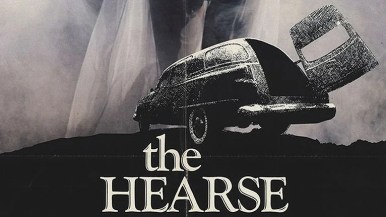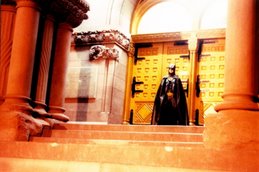Kenji Misumi’s The Ghost of Yotsuya is one of those films that proves ghost stories don’t need jump scares to crawl under your skin. It’s a tale of betrayal, greed, and vengeance that trades gore for atmosphere, letting guilt and paranoia do the heavy lifting. By the time Oiwa’s spectral face floats across the screen, you’re already halfway haunted.
Ruthless samurai Iemon Tamiya (Kazuo Hasegawa) wants to marry Oiwa (Yasuko Nakada), but when he waits outside her home to beg her father, Samon (Shinjirō Asano), for permission, he’s met with ridicule from the man and his companion. Insulted and humiliated, Iemon does what any reasonable suitor would do in a samurai ghost story: he pulls out his sword and butchers them both. Unfortunately for him, a low-rent thug named Naosuke (Hideo Takamatsu) sees the whole thing. Rather than running to the authorities, Naosuke proposes a devil’s bargain—silence in exchange for a slice of the action. Together, they spin a tale blaming the murder on local criminal Usaburo, then decide to really sweeten the pot by tossing Sato’s son and Sode’s fiancé, Yomoschichi (Narutoshi Hayashi), off a waterfall.
 It’s less a romance than a crime spree with wedding bells.
It’s less a romance than a crime spree with wedding bells.
A year later, Iemon has married Oiwa and settled in Edo with their infant son, while Naosuke has slithered his way into Sode’s orbit. But domestic bliss bores Iemon, and the idea of being a respectable family man pales next to the chance to marry Oume Itō (Yôko Uraji), the daughter of nobleman Kihē Ito (San’emon Arashi). He and Naosuke hatch a plan straight out of a kabuki tabloid: poison Oiwa and pin adultery on her, clearing Iemon’s path to the big leagues. Enter Takuetsu (Ryônosuke Azuma), a hapless masseur bribed to seduce Oiwa. But instead of bedding her, he spills the plot. It’s too late—Oiwa, poisoned, finds her face disfigured with grotesque boils. In a delirium of rage, she slashes at Takuetsu and fatally wounds herself. Before she dies, she swears eternal vengeance. Iemon, never one to leave loose ends, kills Takuetsu, nails both corpses to shutters, and tosses them into the river like unwanted furniture.
 When you said ‘til death do us part, you forgot the fine print.
When you said ‘til death do us part, you forgot the fine print.
On the very night Iemon weds Ume, the ghosts arrive to collect. Oiwa’s deformed spectre stalks him, and in his panic, he strikes at the ghost but, instead, slaughters not only his new bride but her parents as well—so much for social climbing. Seeking sanctuary in a Buddhist temple, Iemon finds only more torment. Oiwa’s spirit also pays a visit to Sode, leading her to discover that Yomoschichi survived his waterfall freefall. Reunited, they vow to avenge their families. At the temple, Naosuke tries to outfox Iemon, but ends up butchered for his trouble. When Yomoschichi and Sode confront the fallen samurai, Iemon is finally undone—not by steel, but by the phantoms of Oiwa and Takuetsu, who drive him into madness and leave him helpless. In the end, Oiwa’s spirit is restored to her former beauty, cradling her child in the afterlife, her revenge sated and her soul finally at peace.
 So…um…a happy ending?
So…um…a happy ending?
Stray Observations:
•
Iemon might be the most useless samurai ever—he’s bad at loyalty, bad
at ambition, and somehow manages to be bad at murder too.
• Poisoning someone via “medicine” is peak 18th-century villain efficiency. Subtle, but you still get caught by ghost karma.
•
Fun fact: some productions of Yotsuya Kaidan in kabuki theatre were
said to be cursed, because actors claimed strange accidents happened
during performances. Imagine trying to collect hazard pay for that.
•
Oiwa’s transformation is still terrifying despite being done with
simple makeup effects—proof that you don’t need CGI to ruin a face
(Hollywood, take notes).
 “Her beauty rotted, but her rage is eternal.”
“Her beauty rotted, but her rage is eternal.”
Kenji Misumi, best known in the West for directing samurai epics like Zatoichi and Lone Wolf and Cub, takes a very different tack here. His direction is deliberate, almost suffocating, grounding the supernatural in a world of oppressive shadows and tatami rooms where every sliding door hides potential menace. Misumi understands that horror thrives on patience, and he milks each scene for dread rather than cheap shocks. Every pause, every lingering silence becomes a knife-edge of suspense, as though the film itself is holding its breath. It’s a filmmaker used to swordplay and spectacle, instead turning his blade inward, cutting down to the marrow of fear.
 “Her whisper freezes the blood. Her gaze burns the soul.”
“Her whisper freezes the blood. Her gaze burns the soul.”
Cinematographer Yukimasa Makita’s work is equally essential. The film is drenched in chiaroscuro lighting, with heavy shadows swallowing corners of the frame, while Oiwa’s ghost often emerges from darkness with eerie precision. The camera lingers on faces—especially Iemon’s—as if trying to peel back his soul, and when Oiwa finally appears, the effect is unforgettable: less an apparition than the embodiment of rotting guilt. Makita frames these moments like living scroll paintings, balancing beauty and dread until they feel inseparable. The result isn’t just a ghost story, but a visual descent into psychological torment, where the boundaries between the external world and inner conscience collapse under the weight of betrayal.
 Some brides toss the bouquet. Others toss your sanity.
Some brides toss the bouquet. Others toss your sanity.
In the larger context of Japanese horror, The Ghost of Yotsuya stands as a milestone. It’s part of a long lineage of kaidan tales, ghost stories rooted in Edo-period folklore and kabuki tradition, and arguably the most famous of them all. Long before Sadako crawled out of a television set in Ringu, Oiwa was setting the gold standard for vengeful spirits—an image of betrayal and injustice so potent it has been retold in film after film. Misumi’s version, however, captures that story with stark elegance, stripping away theatrical excess to focus on raw human cruelty and its spectral aftermath. In doing so, he not only honours the kabuki roots of the tale but also ensures that Oiwa’s suffering and vengeance resonate with a timeless, bone-deep chill.
 She’s not just turning in her grave—she’s climbing out of it.
She’s not just turning in her grave—she’s climbing out of it.
In conclusion, The Ghost of Yotsuya leaves you with the kind of chill that has nothing to do with sudden shocks and everything to do with festering guilt and betrayal. Misumi’s direction and Makita’s cinematography trap the story in claustrophobic darkness, while Oiwa’s ghost burns herself into cinema history as the ultimate avenger. It’s elegant, merciless, and still one of the defining works of Japanese horror.







































